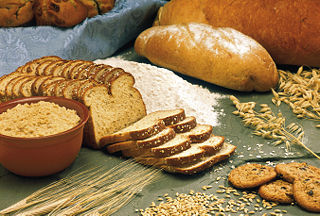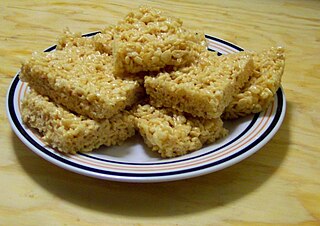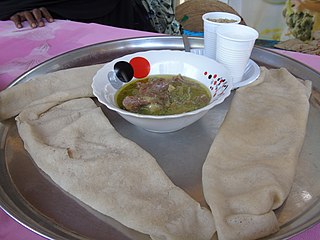
A cereal is any grass cultivated (grown) for the edible components of its grain, composed of the endosperm, germ, and bran. The term may also refer to the resulting grain itself. Cereal grain crops are grown in greater quantities and provide more food energy worldwide than any other type of crop and are therefore staple crops. Edible grains from other plant families, such as buckwheat (Polygonaceae), quinoa (Amaranthaceae) and chia (Lamiaceae), are referred to as pseudocereals.

Breakfast is the first meal of a day, usually eaten in the morning. The word in English refers to breaking the fasting period of the previous night. There is a strong likelihood for one or more "typical", or "traditional", breakfast menus to exist in most places, but their composition varies widely from place to place, and has varied over time, so that globally a very wide range of preparations and ingredients are now associated with breakfast.

Porridge is a food commonly eaten as a breakfast cereal dish, made by boiling ground, crushed or chopped starchy plants—typically grain—in water or milk. It is often cooked or served with added flavorings such as sugar, honey, (dried) fruit or syrup to make a sweet cereal, or it can be mixed with spices or vegetables to make a savoury dish. It is usually served hot in a bowl, depending on its consistency. Oat porridge, or oatmeal, is one of the most common types of porridge. Gruel is a thinner version of porridge.

Breakfast cereal is a traditional breakfast made from processed cereal grains. It is traditionally eaten as breakfast primarily in Western societies. Warm cereals like porridge and grits have the longest history. Ready-to-eat cold cereals, appearing around the late 19th century, are most often mixed with milk, but can also be paired with yogurt instead or eaten plain. Fruit or nuts are sometimes added. Many breakfast cereals are produced via extrusion. Some companies promote their products for the health benefits that come from eating oat-based and high-fiber cereals. In the United States, cereals are often fortified with vitamins but can still lack many of the vitamins needed for a healthy breakfast. A significant proportion of cereals are made with high sugar content. Many are marketed towards children, feature a cartoon mascot, and may contain a toy or prize.

Corn flakes, or cornflakes, is a breakfast cereal made by toasting flakes of corn (maize). The cereal was created by William Kellogg in 1894 for his brother John Kellogg. John Kellogg wanted a food that would be healthy for the patients of the Battle Creek Sanitarium in Michigan where he was superintendent. The breakfast cereal proved popular among the patients, but Will Kellogg wanted to add sugar to increase the popularity. John Kellogg did not approve of this, so Will Kellogg started his own company Kellogg Company to produce corn flakes for the wider public. A patent for the process was granted in 1896, after a legal battle between the two brothers.

The Kellogg Company, doing business as Kellogg's, is an American multinational food manufacturing company headquartered in Battle Creek, Michigan, United States. Kellogg's produces cereal and convenience foods, including crackers and toaster pastries and markets their products by several well known brands including Corn Flakes, Frosted Flakes, Pringles, Eggo, and Cheez-It. Kellogg's mission statement is "Nourishing families so they can flourish and thrive."

Rice Krispies is a breakfast cereal marketed by Kellogg's in 1927 and released to the public in 1928. Rice Krispies are made of crisped rice, and expand forming very thin and hollowed out walls that are crunchy and crisp. When milk is added to the cereal the walls tend to collapse, creating the "Snap, crackle, and pop" sounds.

Baby food is any soft, easily consumed food other than breastmilk or infant formula that is made specifically for human babies between four and six months and two years old. The food comes in many varieties and flavors that are purchased ready-made from producers. Or it may be table food eaten by the family that has been mashed or otherwise broken down.

Rice Krispies Treats are a confection commonly made through binding Kellogg's Rice Krispies or another crisp rice cereal together with butter or margarine and marshmallow. While traditionally home-made, Kellogg's began to market the treats themselves in 1995.

A whole grain, also called a wholegrain, is a grain of any cereal and pseudocereal that contains the endosperm, germ, and bran, in contrast to refined grains, which retain only the endosperm.

Muri, also known as mudhi or murai or laiyya or mamra or parmal or porri or arsi porri or murmure [Chirmure in marathi] is a type of puffed grain from the Indian subcontinent, made from rice, commonly used in breakfast cereal or snack foods, and served as a popular street food in India, Pakistan, Bangladesh and Nepal. It is usually made by heating rice kernels under high pressure in the presence of steam, though the method of manufacture varies widely.

Levantine cuisine is the traditional cuisine of the Levant, known in Arabic as the Bilad al-Sham and Mashriq, which covers a large area of the Eastern Mediterranean. It continues to carry an influentially mainstream character in a majority of the dishes today. It is found in the modern states of Cyprus, Jordan, Lebanon, Israel, Palestine, Syria, and parts of southern Turkey near Adana, Gaziantep, and Antakya. Conversely, some of the dishes listed below may have early origins in neighboring regions, but have long since become traditions in the Levant.

Rice flour is a form of flour made from finely milled rice. It is distinct from rice starch, which is usually produced by steeping rice in lye. Rice flour is a common substitute for wheat flour. It is also used as a thickening agent in recipes that are refrigerated or frozen since it inhibits liquid separation.
Cerelac is a brand of instant cereal made by Nestlé. The cereal is promoted for infants 6 months and older as a supplement to breast milk when it is no longer the sole item in an infant's diet. Cerelac is not a substitute for breast milk and it is advised to continue breast feeding or infant formula along with Cerelac. Cerelac can help babies develop tastes for other food as they are weaned from breast milk. It also contains vitamins and minerals like iron, along with essential fatty acids. Cerelac products also contain probiotics that are found in the digestive tracts of breastfed babies. The brand was first registered in 1949 and it is currently sold in Kenya, Tanzania, Belgium, Denmark, Germany, Spain, Portugal, South America, Central America, North America, India, the Middle East, Nigeria, North Africa, Malawi, Pakistan, Philippines, Ghana, Ivory Coast, South Africa, South East Asia, United Kingdom, Zambia and Zimbabwe.

A grain is a small, hard, dry seed, with or without an attached hull or fruit layer, harvested for human or animal consumption. A grain crop is a grain-producing plant. The two main types of commercial grain crops are cereals and legumes. The term specifically refers to seeds of plants of the grass family, such as wheat, corn, and rice; seeds of non-edible grass species are also often called "grains."

Chadian cuisine is the cooking traditions, practices, foods and dishes associated with the Republic of Chad. Chadians use a medium variety of grains, vegetables, fruits and meats. Commonly consumed grains include millet, sorghum, and rice as staple foods. Commonly eaten vegetables include okra and cassava. A variety of fruits are also eaten. Meats include mutton, chicken, pork, goat, fish, lamb and beef. The day's main meal is typically consumed in the evening on a large communal plate, with men and women usually eating in separate areas. This meal is typically served on the ground upon a mat, with people sitting and eating around it.

Nasi tim is an Indonesian steamed chicken rice. In Indonesian language nasi means (cooked) rice and tim means steam. The ingredients are chicken, mushroom and hard boiled egg. These are seasoned in soy sauce and garlic, and then placed at the bottom of a tin bowl. This tin bowl is then filled with rice and steamed until cooked. This dish is usually served with light chicken broth and chopped leeks.

A staple food, food staple, or simply a staple, is a food that is eaten routinely and in such quantities that it constitutes a dominant portion of a standard diet for a given people, supplying a large fraction of energy needs and generally forming a significant proportion of the intake of other nutrients as well. A staple food of a specific society may be eaten as often as every day or every meal, and most people live on a diet based on just a small number of food staples. Specific staples vary from place to place, but typically are inexpensive or readily available foods that supply one or more of the macronutrients needed for survival and health: carbohydrates, proteins, fats, minerals, and vitamins. Typical examples include tubers and roots, grains, legumes, and seeds. Among them, cereals, legumes, tubers and roots account for about 90% of the world's food calories intake.
















